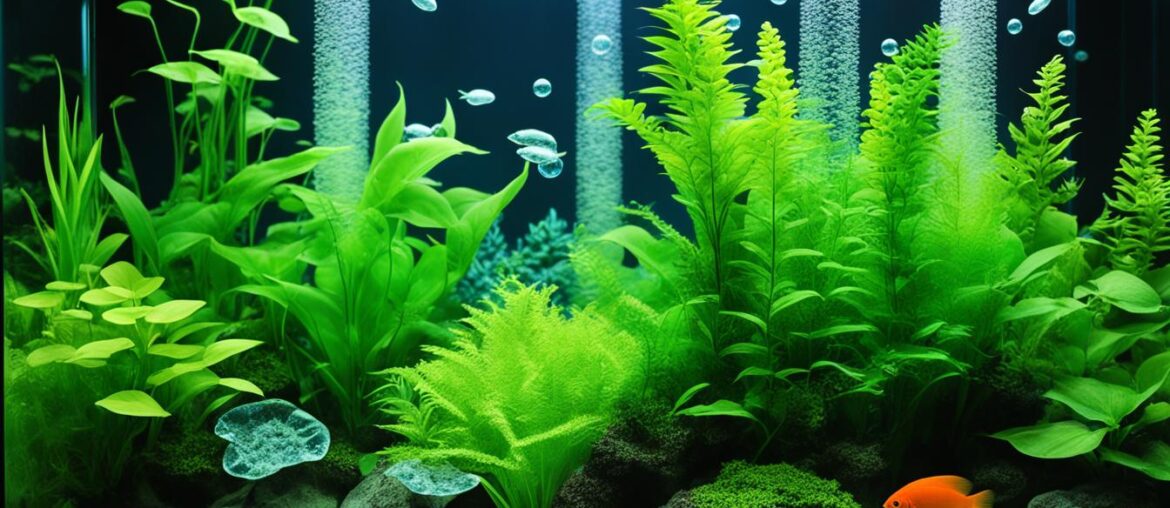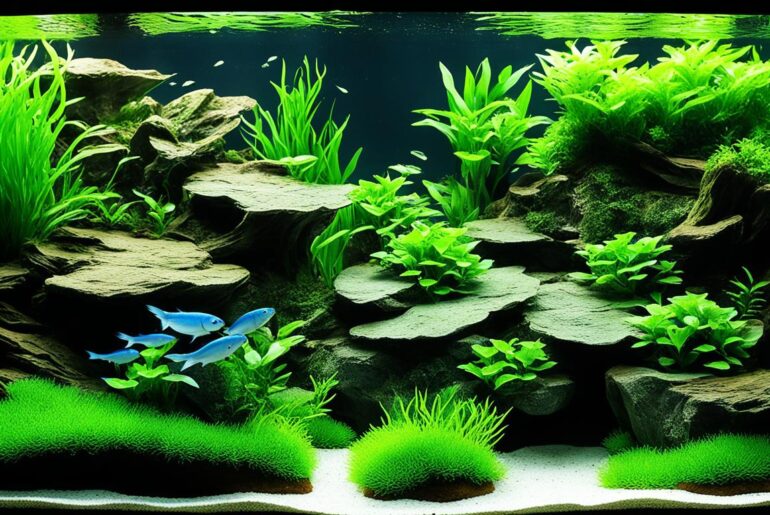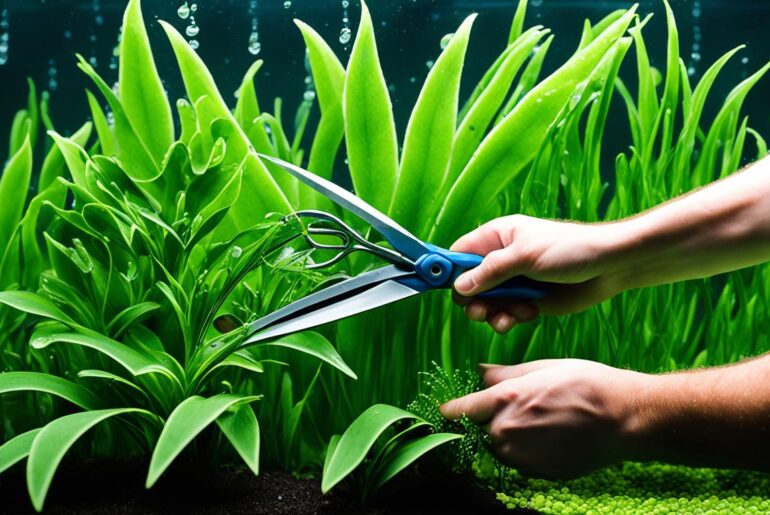My journey into the world of aquarium plants began with a single plant in a small fish tank. It was a humble start, but it soon ignited a passion within me to create a lush and vibrant underwater paradise. As I delved deeper into the hobby, I realized that providing the right conditions for aquatic plants to thrive is key to their success. One crucial component in this equation is a CO2 system.
A CO2 system is like a breath of life for aquarium plants. Just as we need oxygen to survive, plants need carbon dioxide to flourish. It’s the fuel that drives their growth, allowing them to produce the oxygen and nutrients that benefit the entire aquarium ecosystem.
In this comprehensive guide, I’ll take you through the process of setting up a CO2 system for your aquarium plants. From the essential components you’ll need to the step-by-step instructions, I’ll provide you with all the information you need to ensure that your plants receive the optimal CO2 levels they need to thrive.
Key Takeaways:
- Setting up a CO2 system is vital for the healthy growth of aquarium plants.
- CO2 is essential for photosynthesis, the process that helps plants produce oxygen and nutrients.
- There are two main types of CO2 systems: pressurized CO2 and DIY CO2.
- A CO2 system consists of several components, including a CO2 regulator, cylinder tank, diffuser, and more.
- Maintaining the proper CO2 levels is essential for healthy plant growth and algae control.
The Importance of CO2 for Aquatic Plants
CO2 is an essential element for the growth and health of aquatic plants in aquariums. It plays a vital role in the process of photosynthesis, where plants combine CO2, water, and light energy to produce oxygen and sugars. These oxygen and sugars are crucial for the respiration and growth of plants, ensuring their overall well-being.
While some low-light aquariums may naturally have enough CO2 from surface agitation, fish respiration, and organic breakdown, most planted tanks with medium to high lighting require additional CO2 injection. This is because the demand for CO2 increases with higher light intensity, as the plants require more CO2 to meet their metabolic needs for effective photosynthesis.
“CO2 is an essential component for plant photosynthesis and growth. Without sufficient CO2 levels, plants may suffer from growth deficiencies and be more susceptible to algae formations.”
Aquatic plants depend on CO2 as a critical building block in the photosynthesis process, alongside water and light. Without sufficient CO2, plants may experience growth deficiencies, leading to stunted growth, yellowing leaves, and weakened root systems.
Moreover, inadequate levels of CO2 in aquariums can create an imbalance in the ecosystem, providing an opportunity for algae to thrive. Algae can overgrow and outcompete aquatic plants for vital nutrients and resources, negatively affecting the overall aesthetic and health of the aquarium.
By providing an additional source of CO2 through CO2 injection systems, aquarists can meet the increased demands of their aquarium plants and promote their growth and vitality. CO2 supplementation ensures that plants have access to optimal levels of CO2, enabling them to carry out photosynthesis efficiently and thrive in the aquarium environment.
In the next section, we will explore the different types of CO2 systems commonly used in aquariums and discuss the benefits and considerations of each option.
Comparing CO2 Injection Methods
| CO2 Injection Method | Advantages | Disadvantages |
|---|---|---|
| Pressurized CO2 |
|
|
| DIY CO2 |
|
|
Types of CO2 Systems
When it comes to CO2 systems for aquarium plants, there are two main types: pressurized CO2 systems and DIY CO2 setups. Each has its own advantages and considerations, so let’s take a closer look at these options and the equipment needed for each.
Pressurized CO2 Systems
Pressurized CO2 systems are the preferred choice for many aquarists due to their stability and reliability. These systems involve using specific equipment to inject CO2 into the aquarium, providing a steady supply of carbon dioxide for your plants.
The key components of a pressurized CO2 setup include:
- CO2 regulator: To control the flow of CO2 from the cylinder tank
- Cylinder tank: Stores the CO2 gas and comes in different sizes
- Diffuser: Breaks down the CO2 into fine bubbles for better absorption
- Bubble counter: Monitors the flow rate of CO2
- Tubing: Connects all the components together
This system provides a stable and precise way of delivering CO2 to your aquatic plants, ensuring they receive the optimal levels for growth and health.
DIY CO2 Setups
If you’re looking for a more affordable option, you might consider a DIY CO2 setup. These setups involve creating CO2 through fermentation using common household ingredients like yeast, sugar, and water.
While DIY CO2 systems are less stable and require more maintenance compared to pressurized setups, they can still be effective for smaller aquariums or those on a budget. However, it’s important to note that DIY CO2 may not provide as precise or consistent CO2 levels as pressurized systems.
Here are the basic components needed for a DIY CO2 setup:
- Bottle: Used to mix the yeast, sugar, and water for CO2 production
- Tubing: Connects the bottle to the diffuser in the aquarium
- Diffuser: Releases the CO2 into the water
- Other necessary components: Check valves, air stones, or bubble counters can also be used to optimize the setup
While DIY CO2 setups require more hands-on effort and maintenance, they can be a cost-effective way of introducing CO2 into your aquarium for better plant growth.
“Pressurized CO2 systems offer stability and reliability, while DIY CO2 setups can be a budget-friendly alternative.”
Comparing Pressurized and DIY CO2 Systems
| | Pressurized CO2 Systems | DIY CO2 Setups |
|———————|————————|—————-|
| Reliability | High | Variable |
| Stability | High | Low |
| Cost | Higher | Lower |
| Maintenance | Low | High |
| Precision | Precise | Inconsistent |
| Recommended for | Large tanks, demanding plants | Small tanks, low-tech setups |
It’s important to weigh the pros and cons of each type of CO2 system based on your specific needs. Pressurized CO2 systems offer stability and precision, making them ideal for larger tanks with demanding plants. On the other hand, DIY CO2 setups can be a more budget-friendly option for small tanks or low-tech setups.
Now that we’ve explored the different types of CO2 systems available, let’s delve into the specific components that make up a complete CO2 system in the next section.
Components of a CO2 System
A CO2 system consists of several components that work together to provide the aquarium with the necessary CO2. These components include a CO2 regulator, cylinder tank, diffuser, bubble counter, and tubing.
CO2 Regulator
The CO2 regulator is a crucial component that allows you to control the flow of CO2 from the cylinder tank into the aquarium. It helps regulate the pressure and maintains a consistent CO2 flow rate for optimal plant growth.
Cylinder Tank
The cylinder tank holds the CO2 gas and is available in various sizes to accommodate different tank needs. It provides a stable and reliable source of CO2 for continuous plant photosynthesis.
Diffuser
The diffuser is responsible for breaking down the CO2 gas into fine bubbles that are easily absorbed by the plants. It ensures efficient distribution of CO2 throughout the aquarium, facilitating maximum plant uptake.
Bubble Counter
A bubble counter is a useful tool that helps you monitor the rate at which CO2 is being injected into your aquarium. It allows you to adjust and fine-tune the CO2 flow, ensuring it meets the needs of your plants without causing harm to your aquatic ecosystem.
Tubing
Tubing is used to connect all the components of the CO2 system together, allowing the CO2 gas to flow from the cylinder tank to the diffuser. It should be CO2-resistant and securely fitted to prevent any leaks or interruptions in the CO2 supply.
“A CO2 system is essential for providing the necessary carbon dioxide needed to support the growth and health of aquatic plants in your aquarium. By ensuring that all the components of your CO2 system are in place and properly functioning, you can create an ideal environment for your plants to thrive.”
Now that we have a clear understanding of the various components of a CO2 system, let’s move on to section 5, where we will guide you through the process of setting up a pressurized CO2 system for your aquarium.
Components of a CO2 System
| Component | Description |
|---|---|
| CO2 Regulator | Controls the flow of CO2 from the cylinder tank into the aquarium. |
| Cylinder Tank | Holds the CO2 gas and provides a continuous supply. |
| Diffuser | Breaks down CO2 into fine bubbles for optimal absorption. |
| Bubble Counter | Monitors the rate of CO2 injection into the aquarium. |
| Tubing | Connects all the components and allows CO2 flow. |
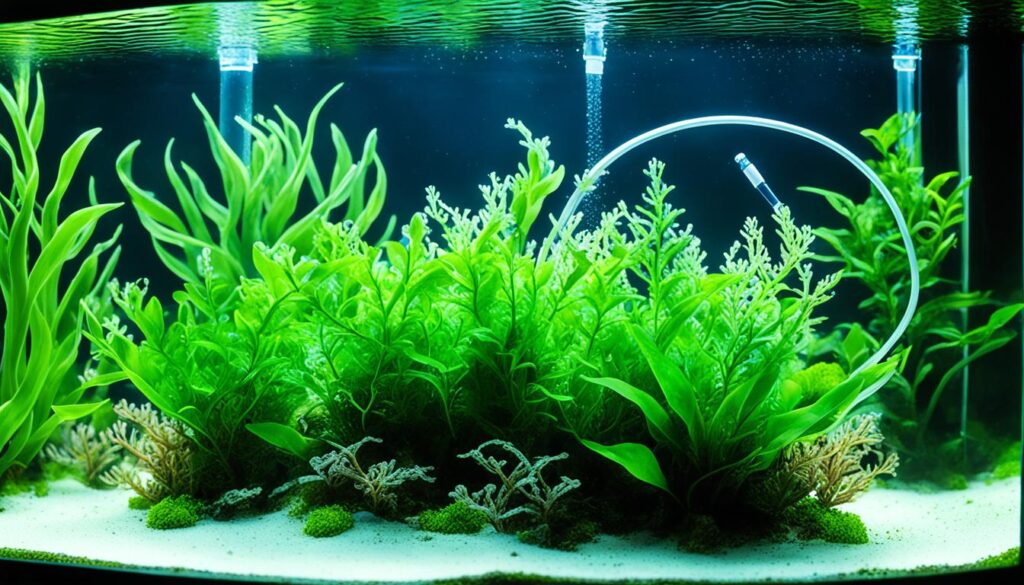
Setting Up a Pressurized CO2 System
To set up a pressurized CO2 system for your aquarium plants, follow these step-by-step instructions:
Gather the Necessary Equipment
Before starting the setup process, make sure you have all the required equipment:
- CO2 regulator
- Cylinder tank
- CO2-resistant tubing
- Diffuser
- Bubble counter
- Solenoid
- Timer
Having these components ready will ensure a smooth installation process.
Attach the CO2 Regulator to the Cylinder Tank
Using a wrench, securely attach the CO2 regulator to the cylinder tank. Ensure it is tightly fastened to prevent any gas leaks.
Connect the Regulator to the Diffuser
Take the CO2-resistant tubing and connect it from the CO2 regulator to the diffuser. This will allow the CO2 gas to flow into the aquarium.
Set Up the Bubble Counter
Install a bubble counter in the CO2 system to monitor the flow rate. Fill the bubble counter with water or mineral oil to make it easier to determine the amount of CO2 being injected into the tank.
Adjust the Needle Valve
On the CO2 regulator, locate the needle valve. Use this valve to adjust the flow rate of CO2. Start with a low flow rate and gradually increase it as you observe the response of your aquarium plants.
Install a Solenoid and Timer
For optimal CO2 usage and to conserve energy, it is recommended to set up a solenoid and timer. The solenoid will control the flow of CO2, and the timer will allow you to turn off the CO2 supply during the night when plants do not require it.
By following these steps, you can successfully set up a pressurized CO2 system for your aquarium plants. This system will provide the necessary carbon dioxide for their growth and help create a thriving underwater environment.
DIY CO2 Systems
Creating your own CO2 system for your aquarium can be a cost-effective alternative to purchasing a pressurized CO2 setup. DIY CO2 systems utilize a process called fermentation, which involves yeast, sugar, and water to produce carbon dioxide. While these systems may require more frequent maintenance and may be less stable compared to pressurized CO2 systems, they can still provide adequate CO2 levels for your aquatic plants to thrive.
To set up a DIY CO2 system, you will need a few essential components:
- A bottle: Select a durable and airtight bottle to hold the CO2 mixture.
- Tubing: Use CO2-resistant tubing to connect the bottle to the aquarium.
- A diffuser: Attach a diffuser to the tubing to disperse the CO2 into the water.
Creating the CO2 Mixture
Mixing the CO2 mixture is a straightforward process:
I recommend using a mix of yeast, sugar, and warm water to create the CO2. Dissolve a teaspoon of yeast and a cup of sugar in a cup of warm water. Stir until the yeast and sugar are fully dissolved, then pour the mixture into the bottle. Seal the bottle tightly and let the fermentation process begin.
It’s essential to monitor the CO2 flow in your DIY system and regularly replace the CO2 mixture as fermentation will eventually slow down. This will help maintain the desired CO2 levels in your aquarium for optimal plant growth.
Attaching the DIY CO2 System
Here’s how you can attach the DIY CO2 system to your aquarium:
- Attach one end of the tubing to the bottle cap and secure it tightly.
- Connect the other end of the tubing to the diffuser.
- Place the diffuser inside your aquarium, making sure it is positioned where water flow is optimal for distributing the CO2.
Remember to adjust the flow rate of the DIY CO2 system as needed to prevent CO2 overdosing and maintain a healthy balance in your aquarium.
Pro Tip: To ensure efficient CO2 diffusion, it’s a good idea to place the diffuser near a strong water current or use a powerhead to circulate the CO2-enriched water throughout your tank.
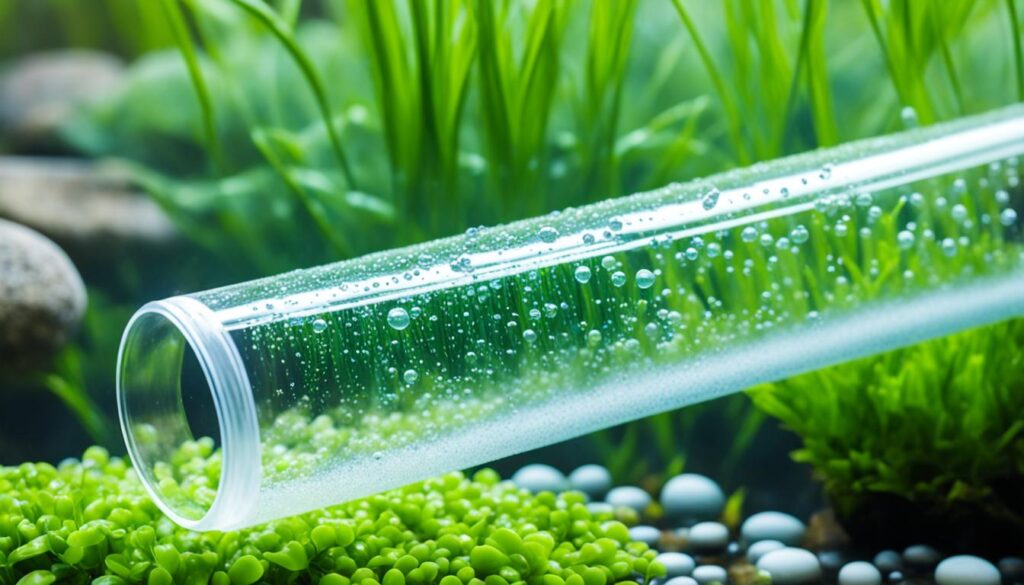
The Pros and Cons of DIY CO2 Systems
While DIY CO2 systems offer affordability and flexibility, they come with a few drawbacks:
| Pros | Cons |
|---|---|
| Cost-effective alternative | Requires regular maintenance and CO2 mixture replacement |
| Flexibility in adjusting CO2 levels | Less stable compared to pressurized CO2 systems |
| Suitable for small to medium-sized aquariums | CO2 production may fluctuate over time |
It’s essential to carefully consider these factors before deciding if a DIY CO2 system is the right choice for your aquarium. If stability and convenience are a priority, a pressurized CO2 system might be a more suitable option.
Importance of CO2 Levels
Maintaining the proper CO2 levels in your aquarium is crucial for the healthy growth of your aquatic plants. CO2 Systems for Aquarium Plants ensure that your plants receive the necessary carbon dioxide they need to flourish. If CO2 levels are too low, it can result in slow or stunted plant growth. On the other hand, if CO2 levels are too high, it can be detrimental to fish and other inhabitants of the aquarium.
To create a balanced and thriving ecosystem, it is essential to monitor and adjust CO2 levels within your aquarium. Using a drop checker or other indicators, you can measure the concentration of CO2 in the water and make any necessary adjustments. By optimizing CO2 levels, you can promote healthy plant growth, minimize algae growth, and create a visually appealing underwater paradise that both you and your fish will enjoy.
The Effects of CO2 Levels on Plant Growth
CO2 is an essential nutrient for plants, and its availability directly affects their growth rate and overall health. Adequate CO2 levels enhance cellular respiration and enable plants to efficiently convert light energy into chemical energy through the process of photosynthesis.
When CO2 levels are insufficient, plants struggle to carry out photosynthesis, leading to slow or stunted growth. In contrast, supplementing CO2 levels in the aquarium provides plants with the raw material they need to produce carbohydrates, which fuel growth and support healthy plant development.
“Maintaining the proper CO2 levels in your aquarium is essential for the healthy growth of aquatic plants.”
Controlling Algae with Balanced CO2 Levels
One common issue among aquarium enthusiasts is the growth of unwanted algae. Algae thrive in environments where there is an excess of nutrients and inconsistent CO2 levels. By maintaining balanced CO2 levels, you can help prevent the overgrowth of algae and create a visually appealing aquarium.
When CO2 is limited, plants struggle to outcompete algae for nutrients, leading to the proliferation of unwanted algae species. However, with optimal CO2 levels, plants can outperform algae, utilizing the available nutrients to fuel their growth. This competition for resources helps to control algae growth and maintain a well-balanced ecosystem within your aquarium.
Monitoring and Adjusting CO2 Levels
Monitoring CO2 levels is crucial for maintaining a healthy aquarium. There are various methods available to measure CO2 levels, such as drop checkers, pH monitors, or test kits. These tools allow you to assess the amount of dissolved CO2 in the water and ensure it falls within the optimal range for your plants.
Once you have determined the current CO2 levels, it may be necessary to adjust the CO2 flow rate to achieve the desired concentration. Fine-tuning the CO2 injection system and observing plant growth can help you find the ideal balance for your specific aquarium setup.
| CO2 Levels | Effects |
|---|---|
| Low | – Slow or stunted plant growth – Increased risk of algae growth |
| Optimal | – Healthy plant growth – Balanced ecosystem – Reduced algae growth |
| High | – Harmful to fish – Potential pH fluctuations |
It is important to note that different types of plants may have varying CO2 requirements. Some plants may thrive in low-CO2 environments, while others require higher levels to reach their full potential. Researching the specific needs of your plant species and adjusting CO2 levels accordingly is key to achieving optimal growth and preventing any adverse effects.
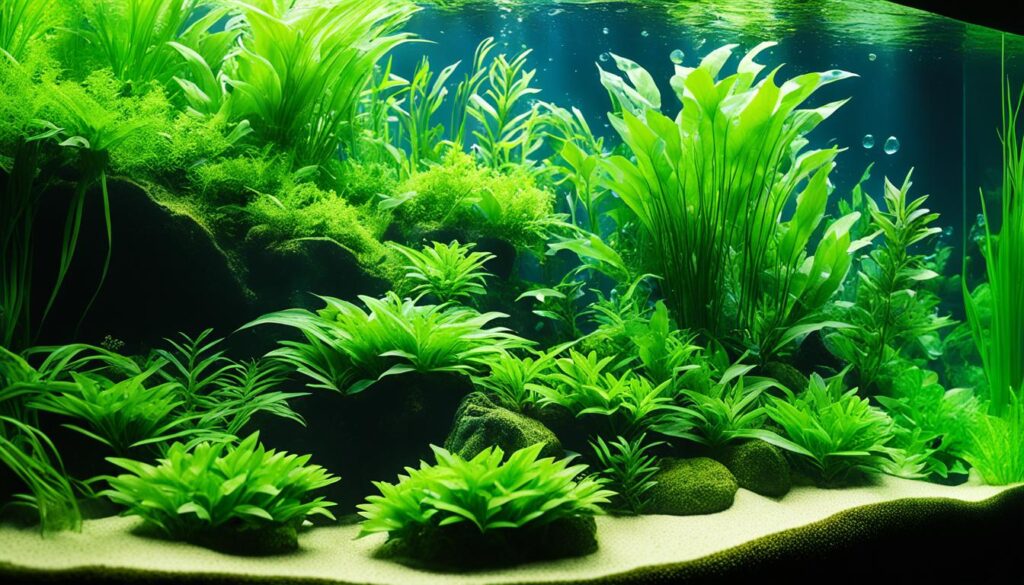
By maintaining and monitoring the appropriate CO2 levels, you can foster healthy plant growth, control algae, and create a thriving and visually stunning aquarium that will be the envy of all who see it.
Tips for Successful CO2 Use
Ensuring successful CO2 use in your aquarium is essential for the health and growth of your aquatic plants. To optimize the CO2 system for your plants, consider the following tips:
1. Start with a lower CO2 dosing rate
When introducing CO2 into your aquarium, begin with a lower dosing rate and gradually increase it over time. This gradual approach prevents any immediate harm to your fish and allows you to observe the impact on plant growth and develop your dosing strategy accordingly.
2. Turn off CO2 at night
Plants do not require CO2 during the dark period, as photosynthesis ceases in low light conditions. Turn off the CO2 injection at night to prevent wastage and unnecessary stress on your fish. Use a timer to automate this process and ensure consistency.
3. Monitor CO2 levels with a drop checker
Use a drop checker, filled with a CO2 indicator solution, to monitor the CO2 concentration in your aquarium. Aim for a green color, indicating an optimal CO2 level. Regularly check and adjust the CO2 flow rate to maintain the desired concentration and promote healthy plant growth.
4. Regularly clean and maintain CO2 equipment
Prevent clogging and ensure proper function of your CO2 equipment by regularly cleaning and maintaining all components. Inspect tubing for algae growth or blockages, clean the diffuser to maintain efficient CO2 diffusion, and check the regulator for any leaks or malfunctions.
5. Closely monitor fish behavior
Pay close attention to your fish’s behavior when adjusting the CO2 levels. Unusual swimming patterns, gasping at the water surface, or increased stress levels may indicate elevated CO2 levels that could be harmful to your fish. Adjust the dosing or flow rate accordingly to ensure the well-being of all the inhabitants of your aquarium.
By following these tips, you can maximize the effectiveness of your CO2 system, promote healthy plant growth, and create a thriving aquatic environment.
Choosing the Right CO2 System
When it comes to CO2 systems for aquarium plants, choosing the right setup is crucial for their growth and overall health. The choice depends on the specific needs and goals of your aquarium. Let’s explore the two main types of CO2 systems: high-tech and low-tech setups.
High-Tech CO2 Setups
High-tech CO2 setups are recommended for tanks with medium to high lighting and demanding plants. These setups utilize pressurized CO2 systems, providing optimal CO2 levels for accelerated plant growth and vibrant colors. By injecting CO2 directly into the aquarium, plants receive the essential carbon dioxide they require for photosynthesis.
High-tech CO2 setups typically consist of the following components:
- CO2 regulator
- Cylinder tank
- Diffuser
- Bubble counter
- Tubing
With a high-tech CO2 setup, you have precise control over the CO2 flow, allowing you to fine-tune the levels to meet your plants’ specific needs.
Low-Tech CO2 Setups
Low-tech CO2 setups are suitable for low light aquariums with less demanding plants. These setups can involve DIY CO2 systems or rely on natural CO2 sources, such as fish respiration and organic breakdown. While they may not provide the same level of CO2 infusion as high-tech setups, they are an affordable and viable option for hobbyists.
Low-tech CO2 setups may include the following components:
- DIY CO2 fermentation system
- Tubing
- Diffuser
With a low-tech CO2 setup, you can create a suitable environment for plants with lower CO2 demands. These setups require regular maintenance and monitoring to ensure steady CO2 production.
When choosing the right CO2 system for your aquarium, consider the lighting intensity and the specific requirements of your plants. Assessing the level of lighting in your tank and the needs of your aquatic plants will help you determine whether a high-tech or low-tech CO2 setup is most suitable.
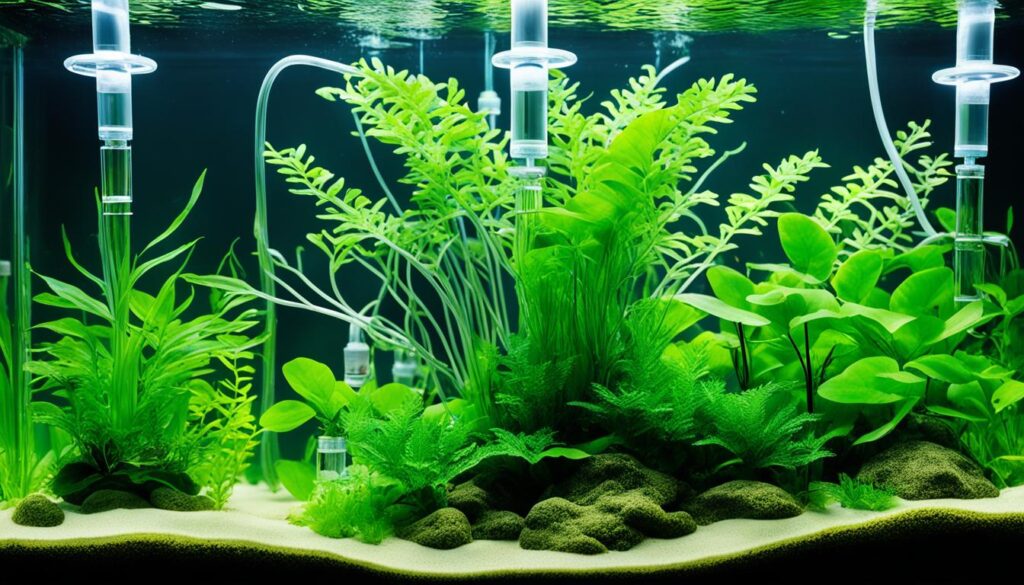
Remember, the right CO2 system can make a significant difference in the health, growth, and overall beauty of your aquarium plants.
Maintenance and Troubleshooting
Regular maintenance is essential to ensure the proper functioning of your CO2 system. By taking proactive measures to clean, inspect, and troubleshoot, you can prevent potential issues and keep your aquarium plants healthy and vibrant. Here are some key maintenance and troubleshooting tips to keep in mind:
Maintenance Tips:
- Clean and inspect all components: Regularly clean the CO2 regulator, diffuser, tubing, and bubble counter to prevent clogging and ensure optimal gas flow.
- Replace tubing and diffuser: If you notice any signs of wear or damage, replace the tubing and diffuser to maintain efficient CO2 distribution.
- Monitor CO2 levels: Use a drop checker or other indicators to monitor CO2 levels in your aquarium. Adjust the flow rate as needed to maintain optimal CO2 concentration.
Troubleshooting Tips:
- Check connections: Inspect all connections, including those between the CO2 regulator, cylinder tank, tubing, and diffuser. Tighten any loose connections to prevent leaks.
- Ensure proper cylinder tank pressure: Check the pressure gauge on your cylinder tank to ensure it is properly pressurized. Adjust as necessary.
- Clean or replace faulty components: If you experience inconsistent CO2 flow or other issues, clean or replace any faulty components, such as the regulator or diffuser.
By performing regular maintenance and troubleshooting, you can maintain optimal CO2 levels in your aquarium and ensure the health and vitality of your aquatic plants.
Conclusion
Setting up a CO2 system is essential for the successful growth of aquarium plants. Whether you choose a pressurized CO2 system or a DIY CO2 setup, providing adequate carbon dioxide is crucial for photosynthesis and plant health. By following the steps outlined in this guide and considering the specific needs of your tank, you can create a balanced and thriving aquatic environment.
Remember to monitor CO2 levels, adjust the flow rate as needed, and perform regular maintenance to keep your CO2 system functioning optimally. With the right CO2 system in place, you can enjoy lush and vibrant aquarium plants that transform your underwater world.
Investing in a CO2 system for your aquarium not only benefits your plants but also enhances the overall aesthetics of your tank. The increased growth and vibrant colors of your aquatic plants will create a stunning focal point in your aquatic display. Don’t hesitate to set up a CO2 system and witness the remarkable difference it can make in transforming your aquarium into a thriving underwater paradise.
So, whether you’re a seasoned aquarist or a beginner, take the plunge and explore the world of CO2 systems for aquarium plants. With a well-designed and properly maintained CO2 system, you can unleash the full potential of your aquatic plants and create a captivating underwater environment that will be the envy of every hobbyist.
FAQ
Why is setting up a CO2 system important for aquarium plants?
Setting up a CO2 system is essential for the healthy growth of aquarium plants as it provides the necessary carbon dioxide needed for photosynthesis, allowing the plants to thrive.
How does CO2 affect the growth of aquatic plants?
CO2 is used in the process of photosynthesis, where plants combine CO2, water, and light energy to produce oxygen and sugars essential for their respiration and growth. Insufficient CO2 can result in growth deficiencies and algae formations.
What are the different types of CO2 systems for aquariums?
The two main types of CO2 systems are pressurized CO2 and DIY CO2. Pressurized CO2 systems are more popular and reliable, while DIY CO2 systems are more affordable but less stable.
What components are needed for a CO2 system?
A CO2 system consists of several components, including a CO2 regulator, cylinder tank, diffuser, bubble counter, and tubing.
How do you set up a pressurized CO2 system?
To set up a pressurized CO2 system, you need to attach the CO2 regulator to the cylinder tank, connect the regulator to the diffuser using tubing, install a bubble counter, and adjust the needle valve for the desired CO2 flow rate.
What is a DIY CO2 system?
A DIY CO2 system involves creating CO2 through fermentation using yeast, sugar, and water. It is a more affordable option but requires more frequent maintenance and is generally less stable.
Why is maintaining the proper CO2 levels important?
Maintaining the proper CO2 levels is crucial for the healthy growth of aquatic plants. Insufficient CO2 leads to slow or stunted plant growth, while excess CO2 can be harmful to fish.
How can I ensure successful CO2 use in my aquarium?
Start with a lower CO2 dosing rate and gradually increase it, monitor plant growth and adjust the CO2 flow rate accordingly, turn off the CO2 at night, use a drop checker to monitor CO2 levels, and perform regular maintenance on the CO2 equipment.
How do I choose the right CO2 system for my aquarium?
The choice of the right CO2 system depends on the lighting intensity and plant requirements. High-tech CO2 setups are recommended for tanks with medium to high lighting, while low-tech setups are suitable for low light aquariums.
How do I maintain and troubleshoot my CO2 system?
Regularly clean and inspect all components, replace tubing and diffuser as needed, monitor CO2 levels, and troubleshoot any problems such as leaks or inconsistent CO2 flow by checking connections and cleaning or replacing faulty components.
What are the benefits of using a CO2 system for aquarium plants?
Using a CO2 system provides optimal CO2 levels for accelerated plant growth, vibrant colors, and minimizes algae growth, creating a balanced and thriving ecosystem in your aquarium.
